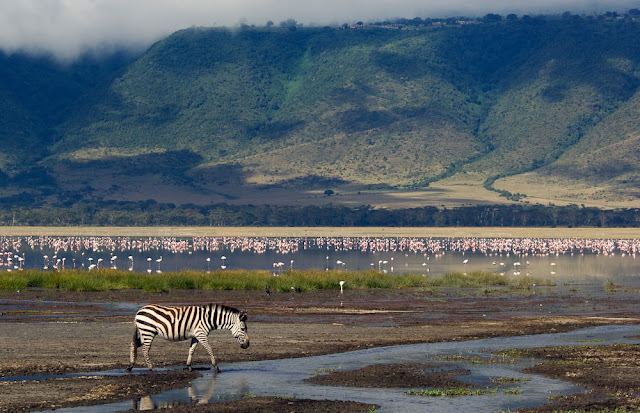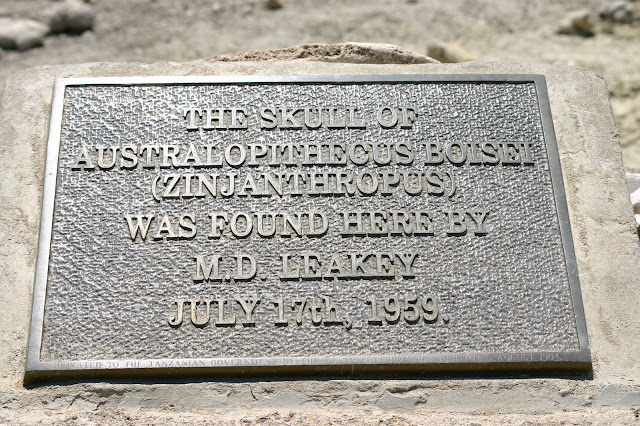The jewel in Ngorongoro's crown is a deep, volcanic crater, the largest un flooded and unbroken caldera in the world. About 20kms across, 600 meters deep and 300 sq kms in area, the Ngorongoro Crater is a breathtaking natural wonder.
A visit to the Ngorongoro Crater is an experience of a lifetime. There are few places that have wildlife densities and variety on this level. It is not unusual to see the Big Five in one day – and all this in the most amazing setting with a backdrop of the 600m/1,968ft-high crater wall.
Ngorongoro Crater Highlights
It was created as a result of an imploded volcano, establishing a unique caldera that stretches 20km in diameter, is home to its very own eco-system and is teeming with indigenous wildlife. Located right near the famous Serengeti National Park, it is ideally located for visitors to explore the variety of plant and animal life living within the crater walls.
This is one of the most magnificent tourist destinations in Africa unparalleled in its distinguished scenic beauty, wildlife and atmosphere. The Ngorongoro Conservation Area (NCA) is an area situated 180km west of Arusha in the Crater Highlands region of Tanzania.
Land in the conservation area is multi-use, it is unique in Tanzania as the only conservation area, providing protection status for wildlife whilst allowing human habitation. The NCA is usually visited on the return journey from the Serengeti to Arusha. Stunning views and unique landscape are a certainty when visiting this spectacular region.
 |
| Masaai settlement |
Wildlife
The Ngorongoro Crater offers some of the best wildlife viewing in Africa. All the major safari animals occur in great numbers. The resident population of black rhino is a real treat, as rhino are very difficult to spot elsewhere in Tanzania. The crater is also home to some very impressive elephant bulls with huge tusks. Lake Magadi often harbors large flocks of flamingo.
Scenery
The Ngorongoro Conservation Area, as a whole, is stunningly beautiful. Aside from the well-known Ngorongoro Crater, Empakaai and Olmoti craters are scenic highlights as well. Both the Ngorongoro and Empakaai craters regularly have flocks of flamingo. The forested crater rim of the Ngorongoro crater is in stark contrast with the crater floor, which consists mostly of grassland. Another feature on the crater floor is Lerai forest, a beautiful, atmospheric, yellow fever tree forest.
Weather & Climate
Conditions at Ngorongoro vary depending on the altitude. Higher up, at the crater itself, it can get quite cold at night, particularly up on the rim. But down in the greater conservation area it stays quite warm. During the area’s Dry season (June to October) there’s barely a cloud in the sky. In the Wet season (November to May) you’ll confront two periods of rain separated by a brief dry spell.
Best Time to Visit
You can spot wildlife down on the crater floor at any time of year. But the viewing is better in the Dry season (June to October) when the undergrowth has receded and animals tend to gather conveniently around waterholes and rivers. The only advantages the wetter months offer are fewer people and low-season accommodation rates.
 |
| Seneto |
 |
| Ngorongoro crater |
Mystery Gorilla Safaris Says
Ngorongoro Crater is one of the most spectacular and unique game reserves in the world. It is easily accessible by road or short flight from Arusha town and naturally forms part of the "northern safari circuit" which also include Tarangire, Lake Manyara and the Serengeti.
Visits to the Crater floor are restricted to half day visits to allow for the large numbers of visitors who all want to see this small reserve. It is easy to cover the entire reserve in the half day allowed. Most camps then provide walking trips on the rim of the crater for the rest of the stay.
The views from the camps along the rim of the Crater spectacular, and it is highly recommended to spend some time relaxing and taking in the views and doing some bird spotting. Birds of prey can often be seen floating over the crater.
How to Get There
Safaris in Tanzania begin at Arusha, which is situated close to the northern safari locations.
Mystery Gorilla Safaris will pick guests from Kilimanjaro International Airport, which is the primary receiving airport in Tanzania. This airport is only a few kilometres away from Arusha airport, which is the safari node of the country and where most light air transfers take off from.
Once guests have landed at Kilimanjaro, they will connect with a road transfer that will take them to Arusha airport. Depending on timing of guests' itinerary, they might spend a night in Arusha before heading off on a scheduled flight to an airstrip or airport nearer their safari destination.
Ngorongoro Crater is a spectacular northern Tanzania safari destination, neighbouring the Serengeti. Guests will fly from Arusha to an airstrip near the Crater and connect with a road transfer that will take them to the lodge.
Airlines & Ticket Prices
Please check Skyscanner, or for multiple-destination flights check Expedia, to see which airlines can take you to Kilimanjaro International Airport (JRO) or Arusha Airport (ARK), and what tickets would cost.
Domestic Flights
Charter flights between parks are typically booked by mystery gorilla safaris as part of the safari tour. Domestic flights can be booked with several carriers:
Coastal Aviation flies to Arusha and Kilimanjaro Airport
Air Tanzania flies to Arusha and Kilimanjaro Airport
Precision Air flies to Arusha and Kilimanjaro Airport
Regional Air flies to Arusha and Kilimanjaro Airport
ZanAir flies to Arusha
Air Excel flies to Arusha and Kilimanjaro Airport
Ngorongoro Crater Game Viewing and Activities
A population of about 25,000 large animals, including the highest density of mammalian predators in Africa, lives in the crater. These include black rhinoceros, hippopotamus which are usually very uncommon in the area. There are also wildebeest, zebra, eland, Grants and Thomson's gazelles.
The crater has the densest known population of lion. On the crater rim are leopard, elephant, mountain reedbuck and buffalo. Lake Magadi, filled by the Munge River in the centre of the crater is, like many in the rift valley, a soda lake supporting flocks of flamingo and a variety of other water birds.
More than a 100 species of bird not found in the Serengeti have been found in the crater including; ostriches, kori bustards, secretary birds, and crowned cranes as well as vultures, egrets, herons and geese.
Half-day game drives are conducted on the Crater floor, but there are no lodges located down there in order to preserve the wilderness and to keep it a pristine game viewing area.
 |
| Gnus |
Wildlife Highlights
A real special of the crater is the black rhino. Rhino is hard to see in Tanzania, and black rhino is typically very shy – sticking to thick vegetation. This is not so in the crater, where they have a predictable routine of spending the night in Lerai forest, and the day in open grassland. Black-backed and golden jackal are equally common in the crater.
Best Time for Wildlife Viewing
Wildlife viewing is excellent in the crater throughout the year. The scenery of the crater is most spectacular in the Wet season, from November to May, but at that time the grass might be long in places. This can interfere with seeing some of the smaller animals. March and April are the wettest months.
Wildlife viewing in the crater is out of this world. All major animals are easily seen. The only exception is giraffe, which is present in the Conservation Area, but not in the crater because of the steep descent. Elephant are common, including some very big tuskers. All big cats can be spotted, and the density of spotted hyena is quite extraordinary.
Ngorongoro CA's climate compared to the Ngorongoro Crater
The Ngorongoro Conservation Area is a vast area with altitude ranging from 1,027 to 3,522m (3,369-11,555ft). Most people only visit the Ngorongoro Crater. They spend the night in a lodge or campsite on the crater rim and visit the crater floor for wildlife viewing. Both the rim (about 2,300m/8,530ft) and floor (about 1,700m/5,577ft) are at higher altitudes and are colder than the overall conservation area. Temperatures drop by about 6.5°C for every 1,000m you climb (or 3.5°F per 1,000ft). The difference is more noticeable during the night. Afternoons on the crater floor will be pleasant, but it can freeze on the crater rim at night. The rim also receives quite a lot of rain.
Dry season –June to October
June, July, August, September & October – Afternoon temperatures are usually around 19°C/66°F on the crater floor. Sunny, cloudless skies are normal, but if the 'short rains' arrive early, they could begin in October. It gets cold at night, and it can freeze on the crater rim.
Wet season –November to May
It gets warmer during the day when compared to the Dry season, but mornings are still cold. Afternoon temperatures are usually around 23°C/73°F on the crater floor, while night temperatures are around 6°C/43°F on the crater rim. There is a chance for freezing temperatures.
November & December – 'Short rains' – These rains are highly unlikely to impact your safari as it won't rain all day. Showers usually happen in the afternoon. The 'short rains' last about one month and can occur anytime between October and December.
January & February – It isn't possible to guess when it will happen with accuracy, but there is usually a time of dry weather between the Wet seasons.
March, April & May – 'Long rains' – This is when wetness is at its peak. Most days will have rain, but it will not last the entire day. The average maximum and minimum temperatures are 21°C/70°F on the crater floor and 6°C/43°F on the crater rim. April and May could experience colder weather due to cold fronts.
















Comments
Post a Comment